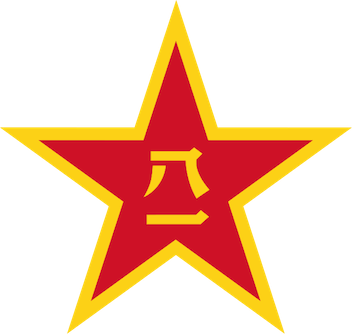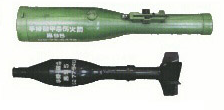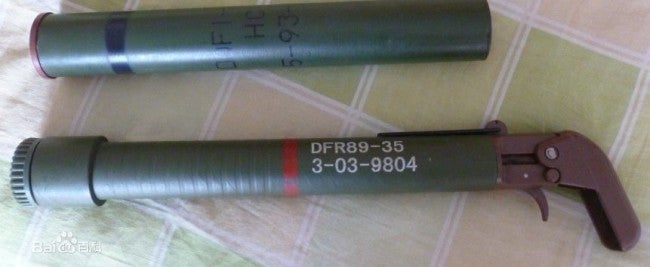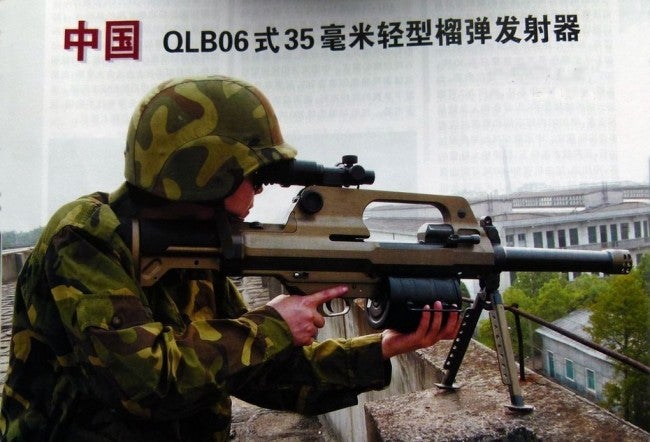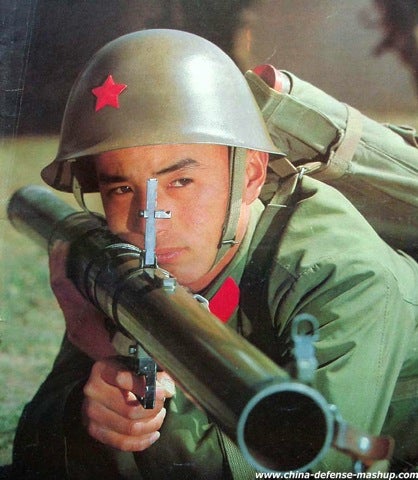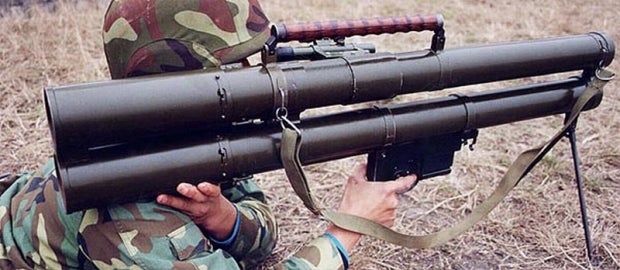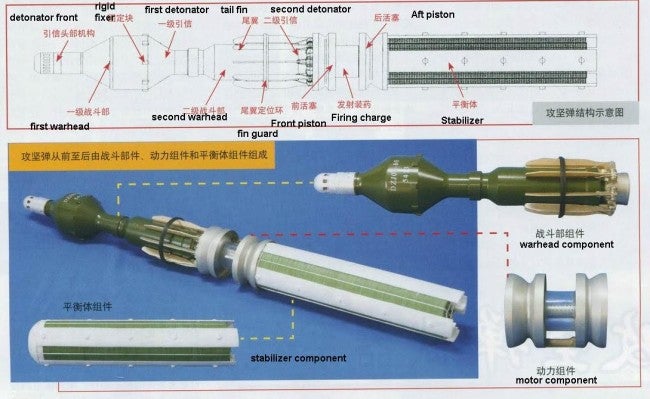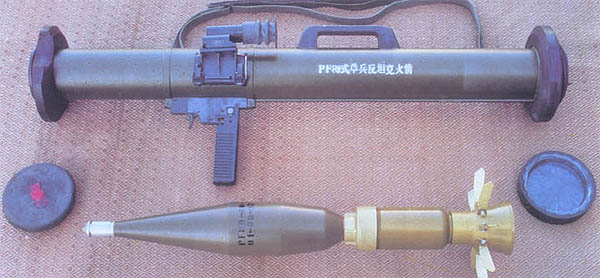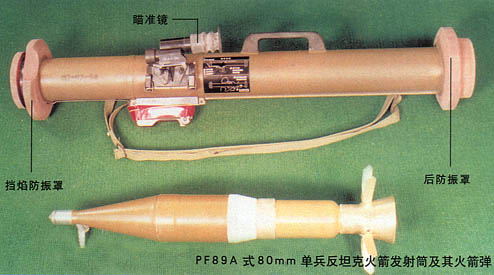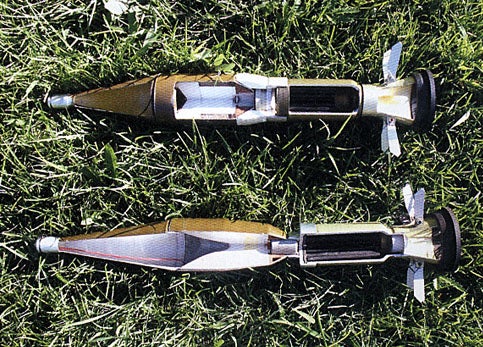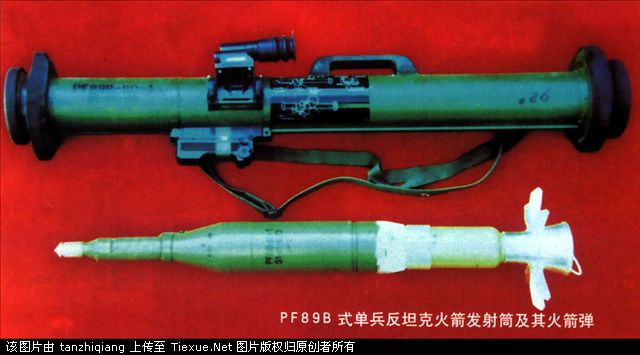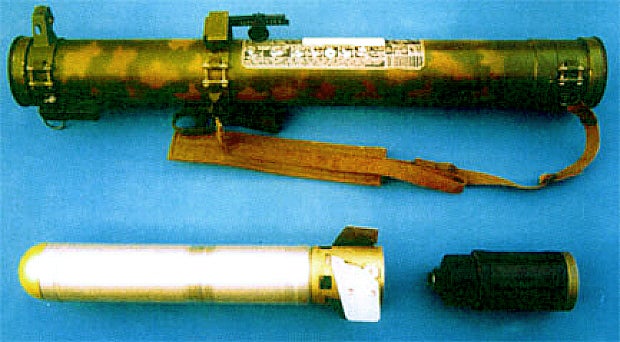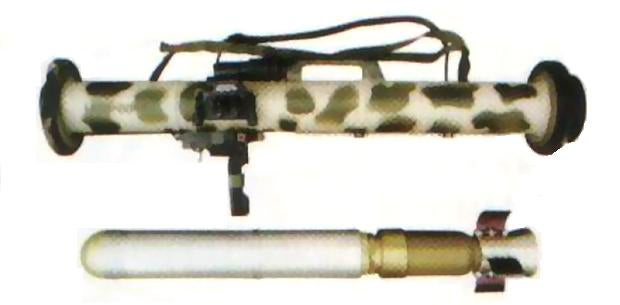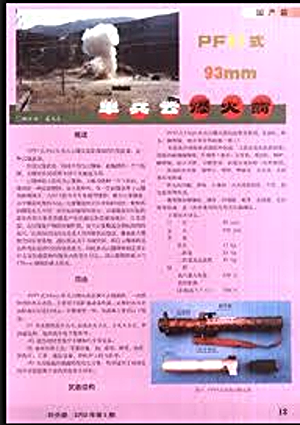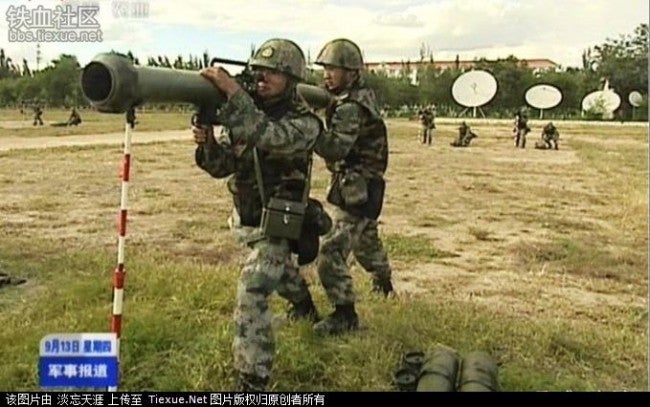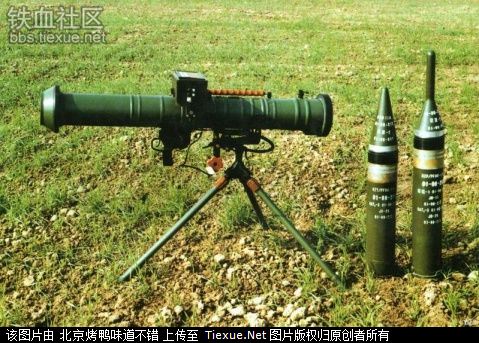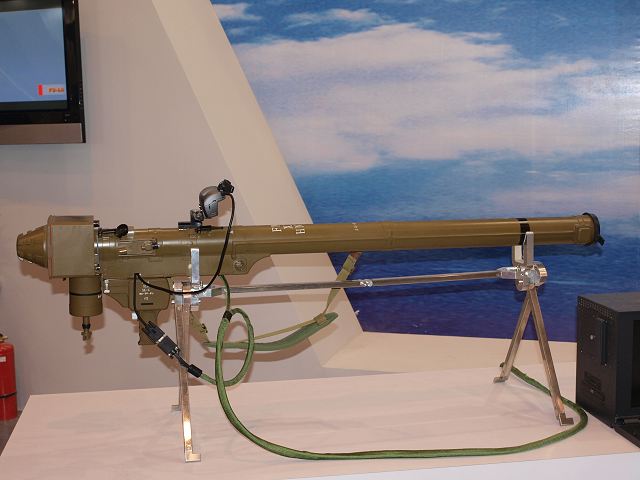This guest post was written by a friend of mine, Curtis, and edited by myself.
Here’s a short overview of Chinese weapons, featuring: Types of launchers that explode for various reasons for various goals currently used in the world. Let’s begin shall we? I’ll be using PLA launchers as the base examples, but providing the closest equivalents of the West and USSR/Russia. Now then, onto the weapons:
Type 79 Mini Rocket
You may be wondering, “hey, where’s the launcher?”, well, that little green tube is the launcher, this thing is quite literally a pocket rocket, or, failing to use the little mini mortar thing, you can release the safety manually and throw it as a contact grenade similar to old Russian AT grenades of WW2 vintage. While It’s intended more as a frag grenade, it has limited armor penetration of around 20-25mm supposedly. (need a clearer citation for this, data for this little thing is hard to find for some reason.)
Closest analogues – ….I have no clue.
Speaking of small, easily concealed devices, onto our next selection, the DFR-89 personal frag-incendiary launcher.
Yet another odd design, this 35mm launcher is really a device small enough to allow any soldier to carry one really, and supposedly has both HE-FRAG and Incendiary options.
Closest analogues – Honestly, this is yet another “unsure”.
QLB-06/QLZ-87B 35mm Grenade launcher
Despite what its proper designation would suggest, this weapon is also reported as a variant of the older QLB-87. This happened because the 87 was originally supposed to be essentially a point GMG, however, a lighter version using smaller drums for reduced weight was often used as a portable launcher, effectively making it a GPGMG. A few things made it rather ill-suited to this, such as the relatively high rate of fire of 480ish rounds per minute with a drum of only 6 rounds. The QLB-06 on the other hand was purpose built for small squads as a light fire support weapon and is semi auto only. Due to it’s design, it’s effective at up to 600m on point targets and 1000m on area targets, and features a wide range of grenades, such as HE-FRAG, HE-I, HE-DP with high armor penetration (Supposedly 80mm RHA at the sacrifice of kill range), and Smoke.
Closest analogues – XM25 for the West as far as intended function goes, maybe somewhat closer to the Milkor MGL or RG-6 as it is a 6-shot “dumb” launcher.
Type 70-1 62mm Rocket Launcher
Some people think that ultra light, small rockets like this are obsolete on the modern battlefield, however, I have to disagree. In many low intensity conflicts, such as Iraq and Afghanistan, you’re not facing the most advanced MBTs and IFVs in the world that can shrug them off. A small explosive launcher like this can disable almost any vehicular threat can easily be disabled or destroyed with a LAW, plus it can flush enemies out of certain fortifications if needed. In fact the M72 of Vietnam vintage is still in limited service, albeit with many upgrades, and this is basically the same thing. It’s a very light launcher that’s very easy to train with, that almost any soldier can use and have on hand in a low intensity conflict. Even in a hot conflict, you’ll have a very light, compact weapon that can still be a threat to lighter vehicles, so while I certainly think such launchers aren’t an answer to everything on a battlefield and need to be supplemented with more capable systems in some situations, they still have their place. While it can be used as an anti fortification and infantry weapon as said before, It can also penetrate an estimated 300mm of RHA.
Closest Analogues – The M72 and RPG-18/22/26 series.
FHJ-84 62mm Incendiary launcher
This is a rather nasty piece of hardware, as it fires either WP Smoke rounds or rounds that burst into a fiery death cloud of metallic incendiary based gel, the obvious use here is against groups of infantry in cover or to get rid of that whole pesky buildings and foliage things to hide in, DO NOT QUOTE ME ON THIS, but I’ve heard it can also fire standard HEAT rounds similar to those used in the 70-1, but considering the 70-1 is a disposable launcher, I’m taking the truth of that one with a grain of salt.
Closest analogues – The M202A1 Flash of Vietnam vintage, which also used a metallic based gel incendiary. (in this case, Trimethylaluminium which is also pyrophoric) and Russian RPO-Z
DJZ08 80mm Multi Purpose breaching launcher
So, this is another special purpose launcher, and while can be used against light-medium armor in a bad situation, albeit with very erratic performance against sloped armor due to the design (300mm penetration at 0 degrees, and a mere 25mm at 65), It’s intended purpose is simple: Breech walls, including those made of things concrete, brick, or other hard materials, and cut through rebar reinforcement, while doing terrible things to anyone on the other side while making a hole large enough for troops to enter following the impact. It’s a very odd design, featuring a shaped charge warhead in front, and a delayed fuze HE warhead on the back. Strangely, according to what I’ve read, this supposedly had magnesium and thermite in both warheads added to cut through rebar and create a genuine molten metal jet (as opposed to standard HEAT where it’s mostly just confusion by the abbreviation) to increase the chance of detonating or igniting anything on the other side that will catch. I do not know if this actually works.
Closest analogues – gonna go with the Matador system used by Germany, Spain, and Israel, and the AST version of the M136.
PF-89 80mm HEAT launcher
So, now we start getting into high intensity conflict level anti armor weapons. Many countries now use disposable AT launchers such as these to give troops a chance against all but the toughest of armor. This is your run of the mill HEAT warhead: it hits a thing, the fuze detonates the high explosive in the back of the charge, the inverted cone embedded facing inwards in the explosive (usually copper) is everted outwards and launches forward at up to 30 kilometers a second by the sheer force, and bad things happen to whatever is in it’s way. The launcher is then thrown out as it’s served its purpose. Armor penetration of the base model is estimated to be around 400mm
Closest analogues – AT4/M136, too many RPG variants to list that fit the role and are disposable.
PF-89A 80mm HEAT-MP
So killing vehicles is good and all, but what if you want to kill vehicles and everyone around them and also decimate bunkers? Well, that’s where HEAT MP warheads come in, while they don’t penetrate as deep due to the shallower, thinner cone as seen below (penetration is roughly cut in half to about 200mm)
(Standard PF-89 missile on the bottom, A variant on top)
It carries a tougher nose allowing to smash through certain objects before bursting and a higher explosive/fragmenting material content, so this can more of less be described as jack of all trades launcher.
Closest analogues: M136 HEDP, RMG
PF-89B 80mm Tandem HEAT
So, a long time ago, some jerks decided to make tanks and other heavy vehicles that have tougher armor, and also add reactive armor on top of that, which counters HEAT warheads in the art of “blowing them tout of the way when activated”, however, reactive armor is not a very smart guy, he is easily tricked, hence, someone, somewhere got the idea to use a more powerful warhead than usual in the back, and a decoy small warhead in the front to trigger the reactive armor while allowing the big boom to go through uncontested.
In all seriousness, yeah, this is a tandem version of the PF-89 above with an updated warhead, Penetration is around 650mm, plus it gets through that mean jerk invention of RHA.
Closest analogues: M136 HP, RPG-27
PF-89-1/2 PF-97 80mm (possibly also 93mm) Thermobaric launcher (?)
Disclaimer: the following may be slightly confusing, as, I’ve had a lot of contradicting sources say the PF-89-1 and 2 are thermobaric versions of the regular PF-89, however, that the PF-97 is just an updated version, or the same thing, however, I then found this little data sheet that indicates the latter is actually a separate 93mm device. (sorry for the crap image quality on this one.)
Maybe they both exist, or just one as 80mm and someone confused the 97 with the RPO-A which is the same caliber, who knows?
These are thermobaric launchers, also known as “yet another thing the UN hates”, they work by creating a super hot overpressure wave by the following, a small charge breaks open the case, releasing the finely dispersed fuel mist that mixes perfectly with the surrounding oxygen in the air. The second sets it off; this creates a very large over pressure wave in the area without the dangers of shrapnel hitting you far away but having devastating effects in the local area, and even being able to inflict severe burns on those not caught directly in the cloud or their lungs if they inhale the burning fuel. Generally, these are quite a bit more effective than standard explosives for most intents and purposes such as anti personnel and demolition work, particularly because thermobarics work at their best in tight areas.
PF-98 120mm Anti Tank launcher
Affectionately known as the Queen Bee, this is a company/battallion level piece that can halt even the toughest of armor and troop advances, It’s a recoilless rifles that can either be shoulder launched or mounted on a low or high sitting tripod, seeing as how aiming old era RRs of this size would be a pain in the rear, this one has some things to help out, such as a X4 adjustable night vision sight with easy to use range correction, and a laser rangefinder and ballistics calculation and fire control computer that links to an LED display for the gunner and can help make corrections for him.
It fires 2 rounds, one of which is a tandem heat charge that penetrates 800mm behind RHA, the other is a general purpose round, description below from sinodefense:
“The multipurpose high explosive round has a warhead with 120 steel balls and incendiary material. This round is capable of piercing 400 mm armor (under 55 degrees). Due to the fragmented nature, it kills the crew inside, or produces fragments to kill other personnel within 25 m of the point of impact. The maximum range is 1,800–2,000 m.”
It sounds very effective against infantry as well.
Closest analogues: honestly, this is a strange one, but, want to go with the Carl Gustav and SMAW, despite their smaller size, they mostly fill the same functionality and design, just not big enough to tackle MBTs from the front.
HN-6 72mm Surface-to-Air missile
You might’ve heard of this, as it’s older brother, the FN-6 managed to cause a minor kerfuffle in certain news agencies when Syrian rebels managed to obtain some and promptly record themselves shooting down 2 Mi-17 Helicopters of the Syrian government last year with said equipment. Secret weapon trades or weapon theft theories aside, This is your typical MANPAD for all your low altitude air defense needs, Not much is known about the missile it uses, it’s believed to be a standard HE FRAG using an annular blast type warhead similar to US Anti air missiles including the Stinger, and have a delayed impact fuze and possibly a magnetic influence secondary. It uses a digital infrared seeker because aircraft happen to do things that generate lots of heat and stuff, but also has a UV guidance option and resistance to countermeasures, the sight is optical with adjustable zoom, night vision enabled, and linked to fire control much like the Queen Bee, and it has an optional IFF screen attachment to prevent friendly fire incidents. Note that variants using the IFF screen are instead called the FY-6, FY-16, and HY-6 respectively.
Closest analogues: FIM-92 Stinger, SA-24 Igla-S
—-
I hope you enjoyed reading and/or learned things and want to discuss it!
 Your Privacy Choices
Your Privacy Choices
